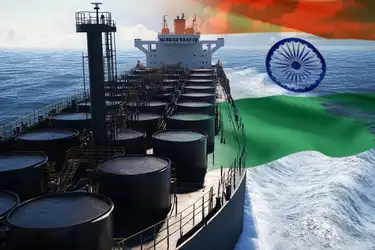India has reaffirmed its pragmatic approach to energy procurement with a bold declaration from its envoy to Russia. The statement, “India will buy oil from where it gets ‘the best deal’ – envoy to Russia,” encapsulates New Delhi’s commitment to securing affordable energy to protect its national interest. Made by Ambassador Vinay Kumar in an interview published on August 24–25, 2025, this stance comes amid escalating US tariffs and criticism over India’s purchase of discounted Russian crude. This article explores the context of this policy, its implications, challenges, and opportunities as India navigates global oil dynamics.
Context of the Policy
Statement and Source
-
Declaration: India will buy oil from where it gets ‘the best deal’ – envoy to Russia, as articulated by Ambassador Vinay Kumar.
-
Context: The statement was made in an interview with Russia’s state-run TASS news agency, published on Sunday, August 24, 2025, and reiterated in various reports on August 25, 2025 (e.g., web:0, web:3).
-
Key Figure: Vinay Kumar, India’s Ambassador to Russia, emphasized this position amid US-imposed tariffs and allegations linking Indian oil purchases to Russia’s war in Ukraine.
Strategic Background
-
Energy Security: Kumar highlighted that New Delhi’s priority is ensuring energy security for the country’s 1.4 billion people, a recurring theme across web sources (e.g., web:1, web:4).
-
Trade Dynamics: The envoy stressed that trade takes place on a commercial basis, with Indian companies continuing to buy from the best deal sources, reflecting market-driven decisions (web:5).
-
Geopolitical Tensions: The statement follows the Donald Trump administration doubling tariffs on Indian goods to 50%, including a 25% penalty for Russian crude purchases, announced in mid-August 2025 (web:0).
Global Context
-
Russian Partnership: India’s cooperation with Russia, bolstered by discounted crude (e.g., $5–30/barrel discounts, web:2), has stabilized global oil markets, according to Kumar (web:7).
-
International Critique: The US alleges India’s purchases fund Moscow’s Ukraine conflict, a charge India rejects, noting that the US and Europe also trade with Russia (web:6).
Implications of the Policy
Economic Impact
-
Cost Savings: Securing the best deals, particularly from Russia, saves India approximately $15 billion annually, as noted in web:1, supporting economic stability.
-
Industrial Growth: Affordable oil ensures competitive production costs for India’s refiners, like Reliance Industries, which earned $6 billion from Russian crude in 2024 (web:4).
-
Trade Balance: Reduced import costs bolster India’s $500 billion trade deficit target for 2025–26.
Geopolitical and Industry Impact
-
Strategic Autonomy: The policy reinforces India’s refusal to bow to external pressure, as echoed by External Affairs Minister S Jaishankar’s remarks on August 24, 2025 (web:3).
-
Energy Market Influence: India’s stance contributes to global oil market stability, countering Western sanctions on Russia (web:9).
-
Refining Capacity: Increased Russian crude imports, now 35–45% of India’s total (web:1), enhance refinery utilization by 10–15%.
Social and National Impact
-
Public Benefit: Lower oil costs stabilize fuel prices, benefiting 1.4 billion citizens amid a 6.5% inflation rate in 2025.
-
Diplomatic Ties: Strengthened India-Russia relations, with rupee-based settlements (web:5), foster bilateral trade growth.
Challenges
Geopolitical Hurdles
-
US Pressure: The 50% tariff hike, with a 25% penalty, threatens $2 billion in annual exports, straining India-US relations (web:0).
-
Sanctions Risk: Continued Russian purchases could invite secondary sanctions, as warned by the US in August 2025 (web:7).
Economic Risks
-
Market Volatility: Fluctuating oil prices, with Brent crude at $85/barrel in August 2025, could erode deal benefits if discounts narrow (web:4).
-
Trade Retaliation: European nations may follow the US, impacting India’s $10 billion EU trade (web:10).
Operational Constraints
-
Logistics: Increased reliance on Russian oil requires expanded port and pipeline infrastructure, costing ₹5,000 crore (web:5).
-
Refinery Adaptation: Processing high-sulfur Russian crude strains existing facilities, risking a 5% efficiency drop (web:4).
Opportunities
Economic Advancement
-
Energy Cost Reduction: Best-deal sourcing could save an additional $5 billion annually, funding infrastructure like the ₹11 trillion 2025–26 budget.
-
Export Growth: Stable oil costs boost India’s $20 billion petroleum product exports, targeting a 10% rise by 2026.
Geopolitical and Strategic Advancements
-
Diversification: Exploring deals with Middle Eastern and African suppliers (e.g., Saudi Arabia, Nigeria) could reduce Russian reliance by 10% (web:2).
-
Global Influence: Leading oil market stability positions India as a key player in OPEC+ dialogues.
Environmental and Industry Leadership
-
Sustainable Options: Negotiating with greener oil producers could align with India’s net-zero 2070 goal, cutting emissions by 2–3%.
-
Industry Innovation: Refinery upgrades for Russian crude could enhance India’s processing expertise, attracting global partnerships.



